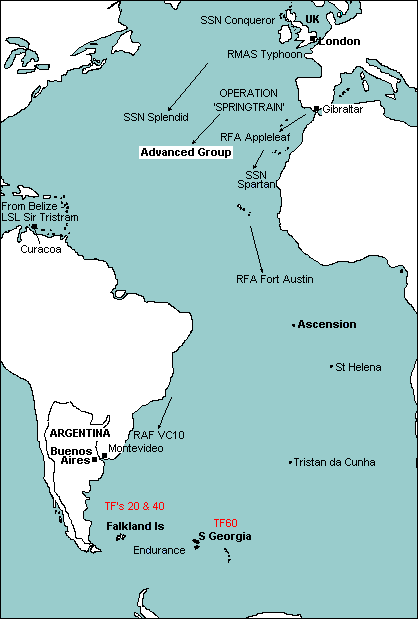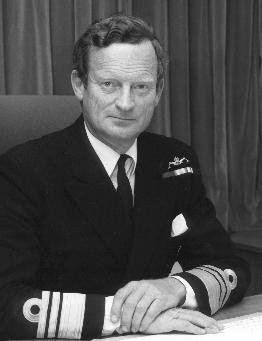
Summary
of British Ships & Aircraft Departing
or on Passage - Forces in Theatre
Royal Navy
All
with Advanced Group:
Antrim, Capt B G Young (awarded
DSO) RN
- Advanced Group
Arrow, Cmdr P J Bootherstone (DSC)
RN
Brilliant, Capt J F Coward
(DSO) RN
Coventry, Capt D Hart-Dyke MVO RN
Glamorgan, Capt M E Barrow (DSO) RN
Glasgow, Capt A P Hoddinott OBE RN
Plymouth, Capt D Pentreath (DSO) RN
Sheffield, Capt J F T G Salt RN
Nuclear Submarines:
Conqueror,
Cmdr C L Wreford-Brown (DSO)
RN -
from UK
Spartan, Cmdr J B Taylor (MID)
RN -
in Central Atlantic
Splendid”, Cmdr R C Lane-Nott (MID) RN - from
UK
Royal Fleet
Auxiliary
Appleleaf,
Capt G P A McDougall RFA - from Gibraltar
Fort Austin, Comm S C Dunlop CBE (DSO) RFA - in
Central Atlantic
Sir Tristram, Capt G R Green
(DSC) RFA - from Belize
Tidespring, Capt S Redmond (OBE) RFA - Advanced
Group
Typhoon, Capt J N Morris RMAS and NP 1820
- from UK
Royal Air Force
VC.10's
of 10 Sqdn RAF, Wing Cmdr O G Bunn MBE
RAF
Hercules of Lyneham Wing RAF
Helicopters
Disembarked
at Gibraltar - No.824 NAS, B
Flt, 2 Sea King HAS.2A's
Falklands
area
British
Ice Patrol Vessel Endurance
Task
Force Departures -
Quite fortuitously, warships of the First Flotilla
commanded by
Rear Admiral Woodward (pictured below) were in the Gibraltar area for "Operation
Springtrain", and before the week was out, many were
heading south. But even before the question of a Task
Force arose, lone "Endurance" needed
replenishment, so on Monday,
RFA "Fort Austin" under the command of the
Fleet Commodore sailed from Gibraltar. She left behind her two assigned Sea
King's of No.824 NAS which played an important part
supplying other ships passing by. Once the go ahead was
given, next to leave on Thursday 1st April and after loading live torpedoes at Gibraltar was
nuclear submarine
"Spartan" whose job was to help establish a
credible maritime exclusion zone. Then on Friday an "Advanced Group" of
"Springtrain" ships started to head for Ascension.
Included with Admiral Woodward's flagship, destroyer
"Antrim" was sister ship "Glamorgan",
Type 42's "Coventry", "Glasgow" and
"Sheffield", frigates "Arrow",
"Brilliant", "Plymouth", and RFA
fleet tanker "Tidespring". Previously on
passage from Curacao to UK, RFA support tanker
"Appleleaf" also sailed from Gibraltar to
refuel Task Force ships on the way
south. Two more nuclear submarines followed
"Spartan" to the South Atlantic, but this time
from Faslane in Scotland. First to go on Thursday was "Splendid" and
within three weeks she was on patrol off the Argentine
coast to shadow carrier "25 de Mayo".
On Sunday, "Conqueror" left, later to sink
the "General Belgrano". Also departing on Sunday was the first of many support
ships - RMAS ocean tug "Typhoon" which sailed
from
Portland for Ascension
before later heading on to South Georgia. Far to the west
of the "Advanced Group" as it started south,
RFA landing ship, logistic "Sir Tristram"
sailed from Belize in Central America for Ascension as the first
of the many ships that later merged as the Amphibious
Task Group.
The RAF also began building the vital
air-bridge to Ascension and beyond when the first
Hercules flew from Lyneham to Gibraltar. However beating them to the South
Atlantic was a VC-10 of 10 Sqdn which left on Saturday for Montevideo to
pick up Rex Hunt and the men of NP
8901. They arrived back
at Brize Norton on Monday. By the end of the week, the first special forces units
were on their way south or about to leave. Some SBS may
have sailed with "Conqueror"
from Faslane, but
most appear to have
flown direct to Ascension.

Rear
Admiral J F Woodward RN,
Commander, Carrier Battle Group
(Courtesy - MOD, Navy)
|